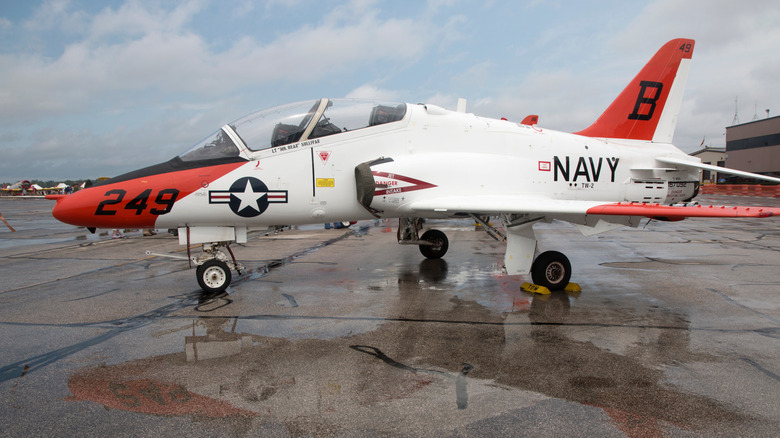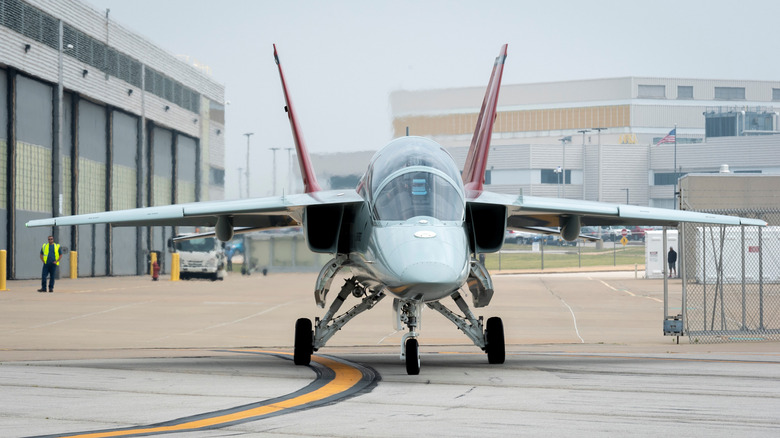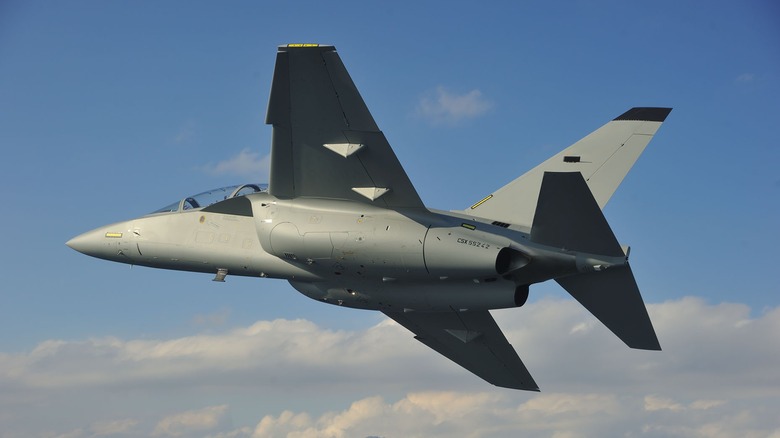What Aircraft Could Replace The Navy's T-45 Goshawk Jet Trainer?
The T-45 Goshawk jet trainer has helped to train generations of Naval pilots since 1991, when the T-45A version first entered service. Over the years, the tandem-seated jet has been used in advanced training roles, including strike missions and carrier aviation. However, the T-45's lineage can be traced back further: The Goshawk is the U.S. Navy's Boeing-built version of the British Aerospace Hawk Advanced Jet Trainer, a plane that first entered service in 1974, and which is still flown by the RAF Red Arrows aerial display team. Since then, the Hawk has trained over 25,000 pilots worldwide and is often used as a crucial lead-in trainer for fighter pilots.
Now, the Goshawk's stint as the US Navy's primary jet trainer looks to be over. In 2025, the Navy announced that it expects to sign a contract to replace its Goshawk fleet within two years. Interestingly, the candidate jets won't need to be carrier-compatible or even take part in simulated carrier landings on land-based runways. These requirements are no longer essential thanks to advancements in ground-based simulations and advancements in automatic/assisted landing systems.
There are several candidates that we know of, including the Boeing-Saab T-7A Red Hawk, the Lockheed Martin-KAI TF-50N, the Textron/Leonardo M-346N, Sierra Nevada Corporation's (SNC) recently unveiled Freedom Trainer, and the Stavatti SM-31 Stiletto. This could be a lucrative and long-term project, with the Navy expected to order 145 jets. With this in mind, it's worth taking a closer look at the planes that could train the next generation of Top Gun pilots.
The established giants and their offerings
Among the candidate planes are those submitted by two of the giants of the U.S. aerospace industry, Lockheed Martin and Boeing. The Boeing entry is the T-7A Red Hawk, a trainer developed in partnership with Swedish firm Saab.
The Red Hawk has already been chosen by the USAF as its new trainer. However, the program has already faced significant delays, and ejection seat issues mean it's not expected to enter service until 2027. Despite that, the trainer's acceptance by the USAF and its advanced stage of development may give it an edge for the Navy. The T-7A is powered by a GE F404 engine, which is capable of producing 11,000 pounds of thrust and 17,000 with afterburner. This gives the Red Hawk a top speed that flirts with the supersonic, with Boeing listing it as Mach 0.975.
Another U.S. defense giant bidding for the contract is Lockheed Martin. In collaboration with Korea Aerospace Industries (KAI), the company has produced the TF-50 training platform, which is an adapted version of KAI's existing FA-50 light combat aircraft. The TF-50 program has the advantage of being ready to go, with over 250 jets already operating or on order. The proposed Navy version is the TF-50N, which would be powered by the same GE F404 engine as the Red Hawk. However, with a listed top speed of Mach 1.5, the TF-50N is substantially quicker than its competitor.
Other contenders for the Navy's training jet
The first twin-engined entrant to the competition is the Textron/Leonardo Beechcraft M-346N. This jet already has a proven record as a trainer with over 100 in service and more than 150,000 training hours logged. Powered by two Honeywell F124-GA-200 engines, the Beechcraft has a maximum cruise speed of 679 mph, making it another subsonic contender for the Navy's consideration.
Textron is a well-known company, producing aircraft under such brands as leading private jet manufacturer Cessna, Beechcraft, and Bell. However, the next company we look at is more obscure. Stavatti's SM-31 Stiletto trainer is perhaps the most unlikely entrant on the list, as the company has never manufactured a plane of any type, never mind a highly advanced military trainer. Stavatti says that the jet will be a single-engined jet trainer with thrust-vectoring capability and will be ready by 2034. Which all seems a big ask for a company without a proven pedigree.
Lastly, we look at SNC, an American company that has proposed a clean-sheet aircraft for the role. It's also the only aircraft in contention that offers carrier landing practice capabilities. The Freedom Trainer is designed to greatly reduce the lifecycle costs of the existing trainer, with engine-related costs alone reduced by 40%. It's another twin-engined jet, with a pair of Williams FJ44-4M turbofan engines supplying the power. SNC says this will give the trainer a performance window similar to that of fourth and fifth-generation fighters.


